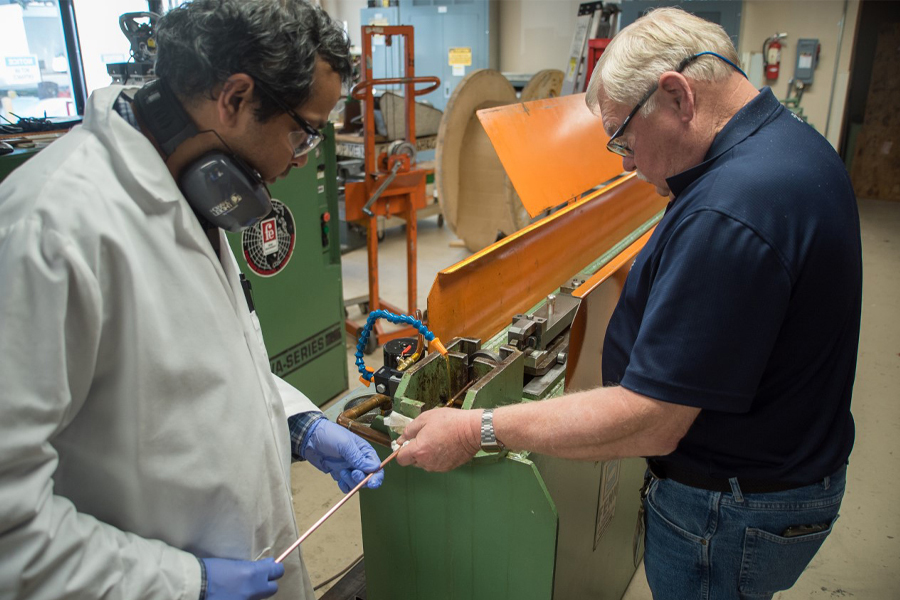Jul 20 2020
Researchers from the National High Magnetic Field Laboratory headquartered at Florida State University have been granted $1.5 million by the U.S. Department of Energy (DOE) to create powerful, more efficient superconductors that could result in robust particle accelerators and new findings about the universe.
 Research scientists Shreyas Balachandran, left, and William Starch draw lengths of niobium-tin superconducting wire at the Applied Superconductivity Center at the National High Magnetic Field Laboratory. A new grant of $1.5 million will allow the group to continue this research. Image Credit: Stephen Bilenky.
Research scientists Shreyas Balachandran, left, and William Starch draw lengths of niobium-tin superconducting wire at the Applied Superconductivity Center at the National High Magnetic Field Laboratory. A new grant of $1.5 million will allow the group to continue this research. Image Credit: Stephen Bilenky.
With the three-year grant, the researchers can continue their earlier DOE-funded study into niobium-tin (Nb3Sn)—a superconducting compound that has been in use for a long time to develop magnets for condensed matter physics research and nuclear magnetic resonance.
The material has been used in the accelerator for the Large Hadron Collider at CERN (the European Organization for Nuclear Research), which discovered the Higgs boson particle in 2012.
According to David Larbalestier, the chief materials scientist at the National MagLab, who also leads the study, the new grant represents a 25% increase in funding. His group has fundamentally redesigned niobium-tin wires to transfer considerably more current, translating into a stronger electromagnet.
The DOE is clearly pleased with our novel rethinking of niobium-tin, a workhorse superconductor whose properties had flat-lined over the last decade. We’re confident that we can continue to improve the compound’s performance until it meets the demands of tomorrow’s particle accelerators.
David Larbalestier, Chief Materials Scientist, National High Magnetic Field Laboratory, Florida State University
In contrast to traditional conductors such as copper, superconductors can transport electricity with the optimal efficiency since electrons do not encounter any friction when they travel in the superconducting wire.
Superconducting magnets form a key part of particle accelerators such as the Large Hadron Collider. CERN has been planning for significant upgrades that will necessitate quite robust superconducting magnets, and the MagLab has been striving to achieve this.
The strategy of Larbalestier’s group was to incorporate the elements zirconium or hafnium into the conductor, a modification that considerably increased the ability of the wire to carry current.
We have succeeded in doubling the current density of niobium-tin at 16 teslas, the hoped-for field of a new generation of accelerator magnets for CERN’s planned Future Circular Collider.
David Larbalestier, Chief Materials Scientist, National High Magnetic Field Laboratory, Florida State University
It has been highly difficult to use niobium-tin to develop the dipole and quadrupole magnets for powering particle accelerators. This is the reason for the use of niobium-titanium—another superconducting material—in these machines to date.
However, research by Larbalestier’s team has helped niobium-tin to emerge as a potential, main ingredient for next-generation higher-energy accelerators. Parallel research studies at Fermilab, Ohio State University, and the company Hypertech has also contributed to the U.S. achievements.
We are pushing the boundaries to understand the limits of niobium-tin by performing fundamental experiments as well as by developing and fabricating practical, high-field, high-current density niobium-tin conductors. This new funding enables us, working with CERN and U.S. industry partners, to improve alloy development, in-house fabrication and characterizing the material’s microstructure to the nanoscale.
Shreyas Balachandran, Researcher, National High Magnetic Field Laboratory, Florida State University
Balachandran is a co-principal investigator on the grant.
During the process of the grant application, Larbalestier’s group was lauded for its effective training of younger researchers to be leaders in the high-energy physics community. Student researchers from the project have been able to work at CERN, Commonwealth Fusion Systems, the Air Force Research Laboratory, and other industries.
The research grant is one of 64 awards related to high-energy physics announced by the DOE and includes $132 million in total. The aim of the grants is to better understand how the universe works at its most basic level.
Scientists from 53 U.S. institutions of higher learning form part of the projects, which include both theoretical and experimental studies into topics like neutrinos, the Higgs boson, dark energy, dark matter, and the search for new physics.
Chiara Tarantini, who has contributed insight into niobium-tin’s behavior and works with Steve Heald at Argonne National Laboratory’s Advanced Photon Source, and Peter Lee, who offers in-depth insights into the micro-, nano-, and macro-structure in such new alloys, are the other co-principal investigators on the grant.